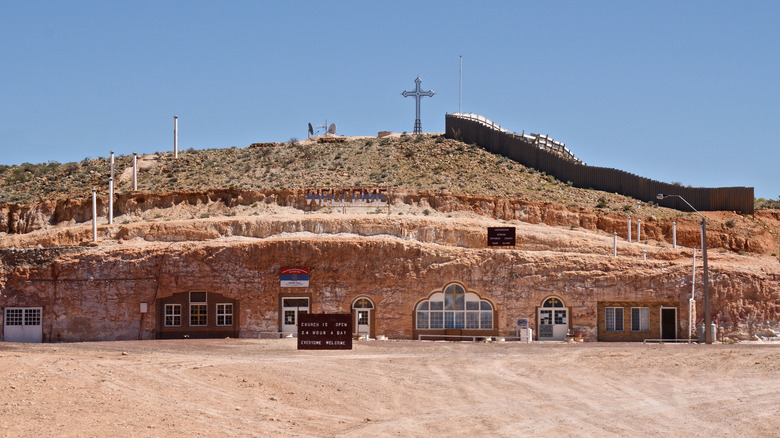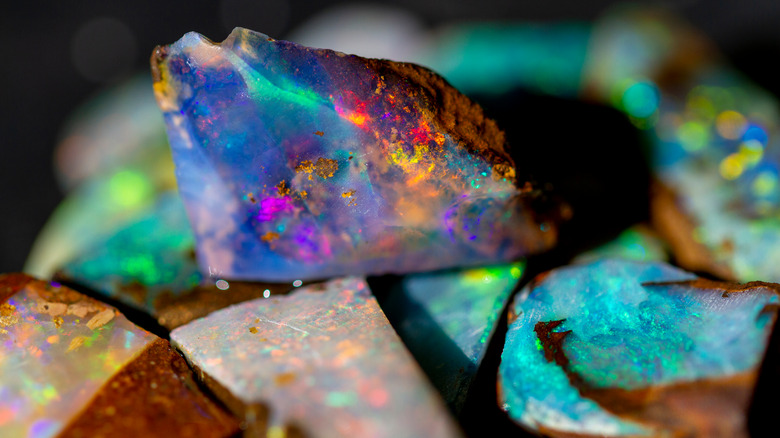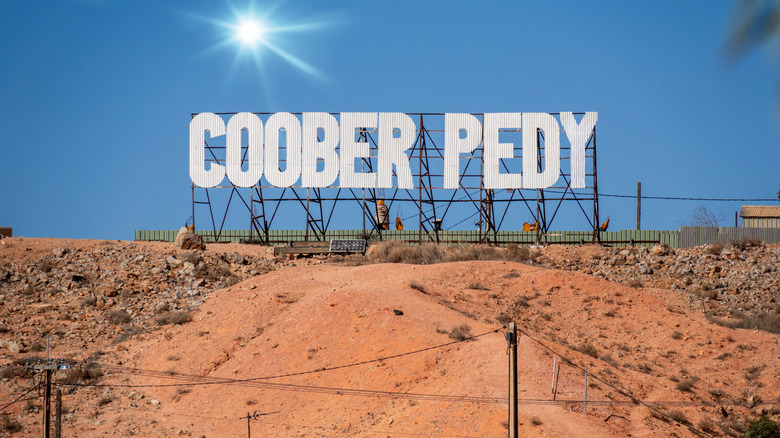A Discovery By A Teenager Led To The Founding Of Australia's Underground City
Located in South Australia, 590 miles from the city of Adelaide, per Britannica, Coober Pedy may be one of the world's most unique towns. Insider explains that it has homes, churches, hotels, stores, and much more. However, nearly everything has been built underground — combating the summer's extreme temperatures, which can reach to 120 degrees Fahrenheit. According to The New York Times, 2,000 residents live in Coober Pedy. Beyond the city's distinct framework, Coober Pedy is known for being the opal capital of the world, the publication notes. In fact, 70% of opal production is connected to this location, according to Smithsonian Magazine.
Coober Pedy states that millions of years ago, the ocean once covered the area. When the water eventually retreated, it left behind silica underground which later formed into opal. A 1985 article from The New York Times reported that mining allowed the city to flourish. Moreover, mining for opal continues to be a way of life for many of the city's residents.
Kenneth Helfand, a prospector living in Coober Pedy, told The New York Times, "What [opal] buys you is freedom, and that's what keeps you digging." Although the Aboriginal people and European settlers had long been familiar with the Coober Pedy region, they were not the ones who discovered this alluring gemstone. That honor goes to 15-year-old William "Willie" Hutchison, according to the Coastal Leader.
Hutchison's search for water led to opal
The Coastal Leader writes that Hutchison, who was also known as Bill, was part of the New Colorado Gold Prospecting Syndicate. Monument Australia explains that this group was made up of a few different men, including Hutchison's father, Jim. The men had come to the region that is now near Coober Pedy to look for gold. When the group was in need of water, the young Hutchison left the camp. According to the Coastal Leader, Hutchison's excursion led him to discover both water and Opal.
Via the Coastal Reader, Hutchison's father recounted this moment in his diaries: "Young Bill had gone bush, and left his water bag behind him, but took his pick and shovel. It was too late to attempt tracking him, so we collected all the wood we could find, which wasn't much, and intended lighting it as soon as it got properly dark, to serve as a guide back to camp, but before we lit it he came quietly into camp and throwing down a sugar bag at my feet said; 'Have a look at that [D]ad, old dear. You will find some good stuff there.'"
The New York Times writes that opal mining began almost immediately. Britannica adds that a community was subsequently established. In 1920, it was given the name Coober Pedy, which is an Aboriginal phrase that translates into "white man in a hole."
Hutchison's legacy
In 1921, a few years after his epic discovery, the young Hutchison drowned in Queensland in a cattle accident, the Coastal Leader states. ABC News Australia reports that his family members do not live in Coober Pedy. Nevertheless, Mayor Steve Staines said, "You just have to walk the streets of Coober Pedy to find all the important families, because there are so many streets named after people who have left legacies in town." Per The New York Times, the city's Hutchison Street has shops and more. Although they are not Coober Pedy residents, Hutchison's descendants are dedicated to keeping the city's history and Hutchison's memory alive.
Per the Coastal Leader, his family, including his nephew Tony Hutchison, attended Coober Pedy's 100th celebration in 2015. Moreover, the Coober Pedy Historical Society released a book that year on Hutchison's story titled "The Boy Who Found Opal." According to Britannica, Coober Pedy thrived in the 1960s and 1970s. Due to its underground infrastructure, the town has become a popular tourist destination and filming location. Robert Coro, from the Desert Cave Hotel in Coober Pedy, told Smithsonian Magazine, "People come here to see things differently." He added, "It's that kind of adventure mentality that attracts people here in the first place.


